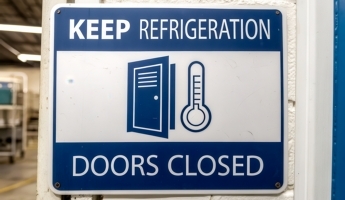How to maintain temperature in your commercial fridge
Listed Under: Blog
The hospitality industry is widely regarded as one of the most stressful in the world, with leaders suffering in particular. If you’re running a café, takeaway, supermarket, restaurant or food van, peace of mind truly matters.
So imagine sitting back, sure that every sausage, sauce and sandwich stays stored safely until service stops. Ahh.
This guide takes you through the simple steps that keep food safe, energy use low, and breakdowns rare in your commercial fridge.
Maintaining the right temperature: food safety and the law
In the UK, food safety is governed by the Food Standards Agency (FSA). Chilled food (that is, food stored in a refrigerator) must stay below 5°C. It’s essential to note that this refers to the internal temperature of the food, not just the temperature setting of the fridge (which should be between 0°C and 5°C). For example, say you cook up gravy for later. How quickly will its internal temperature drop from just below 100°C to 5°C?
Because the real danger is what’s known as the ‘danger zone’. This refers to temperatures between 8°C and 63°C. Between these temperatures, harmful bacteria thrive and multiply. It’s crucial to cool all your hot food (and drink.) to 5°C as quickly as possible, and have it in the fridge within two hours. 5°C provides a buffer zone for any slight temperature fluctuations that might otherwise stray into the ‘danger zone’.
As mentioned, the faster you can cool hot food to 5°C, the better. The safest and most efficient option is a blast chiller. Blast chillers are specifically designed to cool food quickly, so you can put it straight into the fridge or freezer. They’re well worth the investment; they mean much safer food, better texture, more organised workflows, and less lost stock. Because in the hospitality industry, stock is cash.
How airflow and organisation preserve temperature in your commercial fridge
So, how can you make sure your commercial fridge preserves these very specific temperatures? Fridges work via the principle of heat exchange (the same thing as air conditioning). They circulate air through the unit, removing internal heat and thus cooling everything down. The thermostat regulates how much heat to remove.
First of all, try reorganising your units. The internal space needs room to breathe. For instance, if you’ve packed two dozen containers against the back wall on one shelf, that cold air won’t reach the containers in the centre so well. Plus, when airflow gets blocked, the fridge struggles to cool properly. That hits everything inside and pushes up your energy bills.
That means avoiding overcrowding by spacing your refrigerated products throughout different shelves (always adhering to food safety laws such as putting raw meat on the bottom). Use the most appropriate shelving to maximise airflow. Implement a comprehensive labelling system and follow the FIFO (first-in, first-out) system to prevent stock from being wasted. In walk‑ins, in particular, leave a few centimetres between boxes and walls.
If reorganising your refrigerator doesn’t sound like much fun, think of it as fridge‑Tetris. Good stacking equals good cooling, fewer energy spikes, and less wear on the compressor. And that means you win.
Regular care keeps costs down
As with everything – ever – regular maintenance is far more effective than one-off fixes. It’s cheaper, easier to manage, more predictable, and creates a safer storage environment for your produce.
Even if your fridge has its own internal temperature display (as most do these days), add another couple of probe thermometers. Aim for the warmest (usually the highest point) and coolest (usually the lowest point or nearest the cooling element) areas. Next, get your staff to regularly monitor and record these temperatures alongside the displayed figures. You might also find systems that do this automatically. If anything goes wrong with your fridge’s thermostat, this may be the first indication.
And don’t forget about the outside. The condenser coils at the back of the unit are what release the heat into the outside air. If they get dusty or dirty, they won’t work as well. That forces the compressor to work longer, and that means higher energy bills. A quick dust and vacuum every month should be sufficient to keep them working efficiently.
And so much more. On top of the probe thermometers and dusting the compressors, get your staff to carry out the following:
- Place it sensibly – keep fridges away from ovens, cookers, and direct sunlight. Even background heat affects performance.
- Defrost when needed – in warm, humid conditions, manual defrosting prevents ice buildup and maintains steady airflow.
- Check door seals – close a sheet of paper in the door. If it pulls out easily, replace the gasket.
- Limit open-door time – every time a door is open, warm air gets in, and the fridge works harder to cool down.
- Use auto-close doors and train staff – these reduce temperature swings during busy service.
- Install motion-sensor lighting – in larger fridges, this cuts down unnecessary openings and heat from interior lights.
- Book regular maintenance – have professionals check thermostats, refrigerant levels, fans, and seals. It saves more than it costs.
Let Fridgesmart help you
Although it may seem like a lot, these procedures provide you with absolute peace of mind. You’re doing everything reasonable to keep your fridge operating at peak efficiency. As a result, your produce will be flavourful, come with a great texture, and, most importantly, safe.
But if your old units simply can’t cut it, it’s probably time for an upgrade. Our team at Fridgesmart is here to guide you. We’re the UK’s leading supplier of compliant units for all sorts of food- and drink-based businesses across the UK and Europe. With industry-leading products, warranties, and delivery options, we’re sure we’ll have the right commercial fridges for you.
Explore our product range online or reach out for specialist assistance.

 loading...
loading...